The Role of Partially Hydrolysed Polyacrylamide in Modern Applications
Partially hydrolysed polyacrylamide (PHPA) is a synthetic polymer that has garnered significant attention in various industries, including agriculture, oil recovery, and wastewater treatment. This versatile material is a derivative of polyacrylamide, a polymer widely used for its excellent properties, such as high water solubility and thickening abilities. The process of hydrolysis alters polyacrylamide’s structure, which provides PHPA with enhanced features suitable for specific applications.
One of the most prominent uses of PHPA is in the oil and gas industry. In enhanced oil recovery (EOR), PHPA acts as a viscosity modifier in water-based fluids, optimizing the displacement of oil from reservoir rocks. The polymer enhances the mobility of water injected into the wells, facilitating the extraction of oil trapped in porous formations. As a result, PHPA not only improves oil recovery rates but also reduces production costs, making it an invaluable resource for energy companies striving for efficiency.
In agriculture, PHPA plays a crucial role in soil management and erosion control. By acting as a soil conditioner, PHPA improves soil structure and retains moisture, which is particularly beneficial in arid regions. The polymer's ability to bind soil particles enhances aggregation and prevents erosion caused by wind and water. Additionally, PHPA's water retention capabilities support crop growth, leading to improved agricultural yields. As the world faces increasing food security challenges, the use of PHPA could be pivotal in promoting sustainable agricultural practices.
partially hydrolysed polyacrylamide

Moreover, the wastewater treatment sector benefits from PHPA’s flocculating properties. In water treatment plants, PHPA can be employed to remove suspended solids and organic matter from wastewater, promoting cleaner discharge into natural water bodies. The polymer facilitates the aggregation of small particles, allowing them to settle more easily. Consequently, the use of PHPA in wastewater treatment not only enhances water quality but also supports environmental conservation efforts.
In addition to these applications, PHPA has found utility in the mining industry, specifically in the extraction of minerals. The polymer serves as a flocculant in the separation of valuable minerals from waste materials, which increases recovery efficiency and reduces environmental impact. This attribute makes PHPA an essential component in the quest for more sustainable mining practices.
Despite its numerous benefits, the use of partially hydrolysed polyacrylamide is not without challenges
. Concerns regarding environmental impacts and potential toxicity persist, especially in aquatic ecosystems. Therefore, ongoing research is crucial to fully understand PHPA’s long-term effects and ensure that its applications remain safe and ecologically sound.In conclusion, partially hydrolysed polyacrylamide is a multifunctional polymer with significant implications in various fields. Its role in enhancing oil recovery, improving agricultural practices, aiding wastewater treatment, and supporting mineral extraction exemplifies its versatility. As industries continue to seek innovative solutions to meet modern challenges, PHPA stands out as a valuable tool in promoting efficiency and sustainability. Further research and development will be essential to maximize its potential while ensuring environmental protection.

